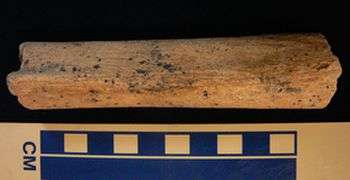September 9, 2013 report
Archeologists date human femur found in northern Britain to 10,000 years ago

(Phys.org) —A trio of archeologists has found that a human femur unearthed in a cave in the early 1990s, in northern Britain dates back to over 10,000 years ago. The combined team of researchers from the University of Nottingham and Liverpool John Moores University has documented their findings in a paper they've had published in Journal of Quaternary Science.
Up until now, remains from humans living in Britain during a warming spell at the end of the last Ice Age, have been confined to caves in the south. Tools and other artifacts have confirmed that people were living in the north as well, but up till now, none of their remains have been found. The bone piece-part of a femur, was found in a cave almost 25 years ago in Cumbria (Kents Bank Cavern) and has since been housed at the Dock Museum. It wasn't until very recently, however, that researchers took a closer look—carbon dating places the bone from the cave at a little over 10,000 years ago which would mean it belonged to a person living during a warming spell (when the ice retreated enough for people to endure) during the last ice age which started approximately 12,000 years ago.
Along with the bone in the cave, the original research team had also found the remains of a horse and a type of deer no longer found in Britain. As part of the new research effort, they were also dated and found to be from roughly the same time as the femur. The new team also discovered that some of the bones from the deer had teeth marks from what appeared to be a wolf or dog. Also, the horse find was interesting because horses were known to have lived in early Britain but went extinct, then were subsequently reintroduced by people bringing them over from mainland Europe.
The researchers point out that caves provide an excellent environment for preserving the remains of deceased people and animals. For that reason, they suggest it's important that remains that are found be kept at a storage facility equipped to keep them in their original found state. This latest find, they say, helps better understand the early history of Britain—it hints at ritual behavior in the north that was similar to that already seen in caves in the south.
More information: New Lateglacial fauna and early Mesolithic human remains from northern England, Journal of Quaternary Science, DOI: 10.1002/jqs.2655
ABSTRACT
Fauna from the Lateglacial Interstadial are largely limited to isolated findspots. Here we report on material from the site of Kent's Bank Cavern, Cumbria, dated to the Allerød/Younger Dryas boundary. The identification of elk (Alces alces) and horse (Equus sp.) and the inferred presence of a large canid indicates that fauna of economic utility to humans were in this area at the time. The presence of humans is attested to by records of Federmesser points from two nearby cave sites. We also report on early Mesolithic human remains from Kent's Bank Cavern. This assemblage represents one of very few Lateglacial faunas in northern Britain, and the most northerly early Mesolithic human remains in the British Isles, making Kent's Bank of importance to discussions of both resource distribution and mortuary rituals in these periods.
Journal information: Journal of Quaternary Science
© 2013 Phys.org


















